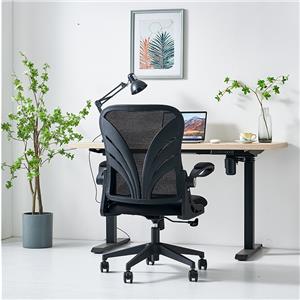Design analysis of ergonomic chairs
The indicators of ergonomic chairs can be mainly divided into three aspects, backrest, seat and armrests. In ergonomic chairs, special attention is paid to the backrest index. Without the backrest, the upper body will not have proper support, and the posture will often appear such as hunching and shrugging, which will lead to abnormal deformation of the spine.
1. Backrest
There are three main factors: backrest curvature, backrest inclination, and backrest edge. Backrest curvature and backrest inclination solve the problem of reducing intervertebral disc pressure, stabilizing the pelvis, and maintaining the normal S-shape of the spine. The appropriate backrest inclination supports the pressure on the back and allows the upper body muscles to relax and rest. Most also have headrest components, which can perfectly support the force on the neck.
In the natural state, the human spine is in an "S" shape. At this time, the pressure on each intervertebral disc is more reasonable, the activity of the muscles in the lower back is smaller, and it is not easy to feel fatigue. When the human spine is in an unnatural state, the pressure within the intervertebral disc is unevenly distributed and muscle activity increases, resulting in soreness, fatigue and other feelings in the human back. The design of the backrest inclination, size and lumbar support points should focus on maintaining the physiological curvature of the human spine. When the backrest angle is set at 115°, the shape of the human spine is close to the natural curved shape, which is more comfortable.
2. Seat
There are four factors related to the seat index: seat height, seat depth, seat width, and seat surface material. A good seat surface material should be breathable, have a certain amount of friction to reduce body slippage, and have moderate hardness and softness to increase the contact surface and reduce pressure. Unevenly distributed features. The major factors of seat height, seat width, and seat depth need to maintain a corresponding relationship with the relevant dimensions of the human body to obtain good use effects.
Unreasonable design of seat height, seat depth and seat inclination will cause human fatigue. When the human body sits on seats of different heights, the angles formed by the calves and thighs are different, the pressure on the legs and buttocks changes, and the comfort of the human body will also change. When the seat surface is low, the angle between the human body's calves and thighs is a smaller acute angle, and the body's pressure is mainly concentrated on the buttocks. Excessive local pressure on the ischial nodes can easily cause soreness and numbness in the buttocks. When the seat surface is high, the angle between the human body's calf and thigh is greater than 90°, and the front of the thigh is compressed, causing poor blood flow and easily causing leg pain. A reasonable seat depth should ensure that the lumbar spine is supported by the backrest to maintain normal lumbar curvature. At the same time, there should be a certain distance between the knee and popliteal fossa and the front edge of the seat to ensure smooth blood flow to the legs. A smaller seat depth will cause greater pressure due to less contact area with the seat surface. A larger seat depth will squeeze the knee and popliteal fossa, resulting in poor blood flow in the legs or ineffective waist function. Support, these will cause fatigue to the human body. If the seat surface is tilted too far forward, the human body will tend to slide down. If the seat surface is tilted too backward, the lower back will be squeezed by the backrest, causing the lumbar curvature to change.
3. Armrest
The ergonomic factors related to armrest indicators include armrest height, armrest width, and armrest length. The armrests mainly serve to support the arms and relax the shoulders and neck in a sitting position. The armrest element is a necessary element in leisure chairs, but not necessarily a necessity in work chairs. Some work chairs will remove the armrest element for the sake of economy and convenience. The above factors often influence and interact with each other. For example, the depth of the seat determines the depth of the armrests, and the inclination of the seat surface affects the inclination of the backrest.
The height of the armrest should be set with reference to the height of the human arm in a sitting position. The armrest is too high, and the arms cannot be placed naturally on the armrest, forcing the shoulders to hunch, causing increased activity of the neck and shoulder muscles, causing neck and shoulder discomfort. The armrests are too low and you have to bend down to place your arms flat on the armrests, which stretches the muscles in your lower back and causes pain in your lumbar muscles. The distance between armrests should ensure that people have a certain degree of movement after sitting down. Narrow armrest spacing makes people feel cramped and makes it difficult to adjust the sitting posture; armrest spacing that is too large will not provide good support to the arms, causing shoulder fatigue.




